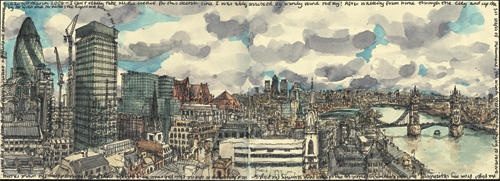Fancy a romantic trans-Atlantic cruise with your sweetheart? How about a nice, relaxing voyage where you row 16 hours a day for 60 days, eat lukewarm freeze-dried food, roll your vessel upside down four times, and fend off the amorous advances of a 60-foot whale? Meet Liz O’Keeffe and Richard Mayon-White, two British adventurers (see photo below) who have done all that and much, much more. I interviewed them at Nelson’s Dockyard in Antigua, West Indies. 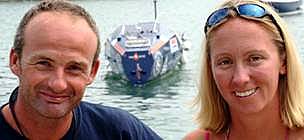
Q: Tell me about the voyage.
Richard: Just a few days ago, on January 30, 2006, we completed our 2900-mile row across the Atlantic, as part of the Atlantic Rowing Race. We are the first mixed pair team to finish here in Antigua. This type of racing began in 1995 and is now very popular.
Liz: The Race included 26 teams who set off on the 30th of November 2005 from Gomera in the Canary Islands. Most teams were pairs, but there were four vessels with four persons aboard, and two solo rowers. Our team is named Row4Cancer and we have raised over 40,000 [$75,000] for cancer relief. We often use the boat to carry cancer sufferers, especially kids, for short races to take their minds off their troubles. They love it.
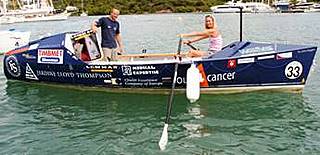 Q: Tell me about your boat.
Q: Tell me about your boat.
Liz: Our boat is named Bilbo Baggins, after the Hobbit character and after our wonderful black Labrador who sadly had to be put down, and is buried near where we kept the boat.
Richard: The race requires all boats to be of a standard size – 24 feet long with a nine millimetre [about inch] thick plywood hull. There is no real competition regarding external boat design. But each team can design their vessel’s interior. We bought a used boat, gutted it, and rebuilt every single system – electrical, navigation, steering, rowing, communications, water-making, cooking, etc. It took three years and required a budget of 60,000 [$113,000].
Q: How old are you, where are you from, and what is your profession?
Liz: I am 29, from Poole in the UK but born in Holland, and I work in insurance sales.
Richard: I am 39, from Oxford, and am a consultant in leadership and personal development. We live in Southampton now.
Q: How did you prepare for the race?
Richard: We both compete regularly in triathlons, Ironmans and marathons. We both have our Royal Yachting Association Yachtmaster Offshore and other RYA qualifications, and have both taught sailing. I climbed Kilimanjaro and Mt. Aconcagua (the highest mountain in South America) and other peaks. I sailed in the famous Fastnet yacht race, and we did lots of weight training, rowing in the gym, and rowing the boat when it was ready.
Liz: I competed at the national level in sailing, netball, trampoline, tennis, triathlons and rugby. Before the start we both bulked up, which was a good thing, since we both lost over 24 pounds during the race. While racing we ate mostly freeze-dried food, which we boiled in the bag.
Richard: We figure that two-thirds of this kind of race is in the preparation, and if you get to the start line, the chances are good that you will finish.
Q: Tell me about your whales.
Richard: We saw lots of whales and dolphins. One calm day a 60 foot sei [baleen] whale came up on us. He dwarfed our little 24-foot boat. For 45 minutes he circled our boat, eyeing us.
Liz: He seemed to be kind of lonely. Our boat has grey antifouling paint underneath and our oars look kind of like flippers, so after a while we realized that he thought we were an odd but attractive female!
Richard: Yes, he had a little twinkle in his eye, and seemed keen for some joy in life. At one point he got underneath the boat and looked up at us, rather plaintively.
Liz: We tried to gently row away, to give him the message that we weren’t interested. But as soon as we started moving he dashed after us. Finally he gave up and we crept away.
Richard: Another time we were in a storm surfing some big waves, and we saw a big whale surfing down after us. But we got away from him, too. We never saw any sharks, although two race boats were attacked by sharks.
Q: What sort of other problems did you have?
Richard: Everyone expected that the race would have fairly calm weather, like most years. And we hoped to break the mixed pair record of 53 days for the crossing. But the 2005/6 hurricane and storm season lasted so long that everyone had troubles. All the boats were affected by hurricane Epsilon, tropical storm Zeta, and by other smaller storms. We rolled over four times.
Liz: All the boats are self-righting if the vents and doors are closed. But it is so hot, humid and miserable inside the tiny 6-foot cabin when everything is buttoned up that it is very hard to keep it closed. About 400 miles from the finish we saw one of the two support vessels, which always seemed to bring us bad luck. Right then we surfed down a big wave and broke our rudder. We tried to fix it for a day, but rolled again.
Richard: Then we were rolled a third time. Liz was rowing and I was in the cabin.
Liz: A massive wave broke over the boat. I was wrenched out of the rowing seat and thrown overboard. I thought I had broken my leg. But I managed to swim back and get over the gunwale, which luckily was very low because the boat was swamped. I was in agony for about 24 hours, but rested up and kept going. My leg wasn’t broken, after all – it was only a torn muscle.
Richard: Our vent was open and so we got lots of water inside, and of course our gear was a mess. But we bailed her out, kept afloat, immobilized Liz’s leg, and managed to fix the rudder after five days of work. At that point we just focused on survival. We never thought we’d make it to Antigua.
Liz: Probably the worst part of the trip was hanging on the sea anchor for days, waiting for the storms to subside. Then the cabin is like being inside a washing machine, it’s so rough.
Q: What was your fastest speed?
Richard: We recorded an unbelievable speed of 18.6 knots surfing down some huge waves. The noise and vibration were incredible. Normally when rowing we average one or two knots over the ground [distance actually made good], and 70 percent of that is probably current. We are not allowed to hoist any sails, of course.
Q: After all this are you still keen on getting married?
Richard: Yes, we were engaged before the race and we are still engaged.
Liz: We know some pairs that went ashore after the race, walked off in opposite directions, and never spoke to each other again. But we want to keep having adventures together.
Q: What plans do you have?
Richard: We have a long list of projects. We think this kind of adventure helps define us as people. I want to sail around the world alone. I want to race in the 100-mile portion of the Tour de France that is open to the public, bike in the Race Across America, drive in the Plymouth to Dakar 100 car challenge, climb Mt. Denali [McKinley] in Alaska, sail in the Sydney—Hobart yacht race, and participate in the Iditarod sled dog race.
Liz: We are thinking of climbing Mt. Vinson in Antarctica for our honeymoon.
Richard: Yes, we want to have some stories to tell our children and grandchildren.
Toulmin: Somehow,
I don’t think that will be a problem.
For more information, see www.row4cancer.com. The race organizers, Woodvale Events, are planning an Atlantic Race in 2007-8 and an Indian Ocean Rowing Race in 2009, if you want to get started on your preparation. See www.woodvale-events.com for details of these races and other individual adventure projects.
About the author: Lew Toulmin is the author of The Most Traveled Man on Earth, which describes the most travelled people, their travel tips and wisdom, and also his adventures in catching up — he has worked in 30 countries and visited 170 countries and sovereign territories. Lew’s book is available from www.amazon.com or www.amazon.co.uk, or direct from The Village Press, 13108 Hutchinson Way, Silver Spring, MD 20906 USA, at $16.95 plus shipping ($5 to the US or $14 overseas). He can be reached at LewToulmin@aol.com
About the photos:
1. Richard Mayon-White and Liz O’Keeffe in Antigua just after completing their 2900-mile row across the Atlantic. In the background between them is their vessel Bilbo Baggins.
2. Richard Mayon-White and Liz O’Keeffe of team Row4Cancer aboard their vessel Bilbo Baggins. Liz shows her rowing position just before being thrown overboard in one of the four rollovers the team suffered during the trans-Atlantic race.
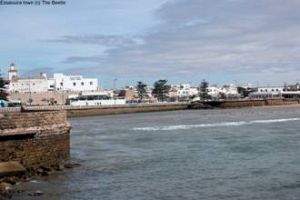 Essaouira is a charming seaside resort situated on the Atlantic Sea in Morocco. It has been a fishing village for centuries, but recently it has become a thriving tourism destination for those seeking a rest by the sea that is not Agadir, Morocco’s better busy and more commercialised known seaside resort.
Essaouira is a charming seaside resort situated on the Atlantic Sea in Morocco. It has been a fishing village for centuries, but recently it has become a thriving tourism destination for those seeking a rest by the sea that is not Agadir, Morocco’s better busy and more commercialised known seaside resort.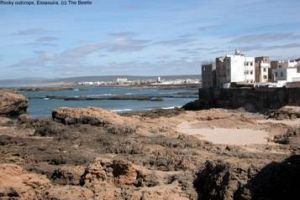 Essaouira is well connected by good roads – Marrakech is 175 km east, Safi 130 km north and Agadir 185 km to the south. Casablanca is 350 km north-east. It is a beautiful town with a mixture of Portuguese, French, and Berber architecture.
Essaouira is well connected by good roads – Marrakech is 175 km east, Safi 130 km north and Agadir 185 km to the south. Casablanca is 350 km north-east. It is a beautiful town with a mixture of Portuguese, French, and Berber architecture. 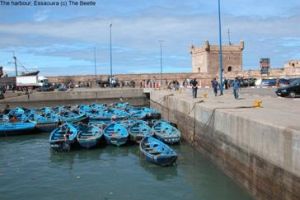
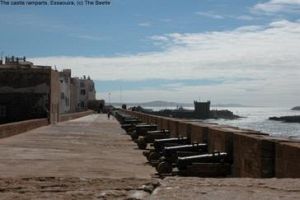


 Mac has not been very well but is still e-mailing strong. Here are some of Mac’s tales of travel to high altitudes and also an update on Stanley, one of Mac’s fellow residents of the Old Soldier’s home in Washington. Stanley belongs to an organisation that distributes eye glasses to those in less developed countries.
Mac has not been very well but is still e-mailing strong. Here are some of Mac’s tales of travel to high altitudes and also an update on Stanley, one of Mac’s fellow residents of the Old Soldier’s home in Washington. Stanley belongs to an organisation that distributes eye glasses to those in less developed countries.
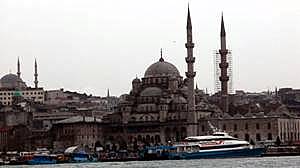 A bit of history about the name: the English name comes from a Greek legend concerning Zeus who had an affair with a beautiful women called Io. When Hera, Zeus’ wife discovered his infidelity, she turned Io into a cow and created a cloud of flies to sting her on the backside. Io jumped across the strait and the name Bosphorus is said to mean the ‘crossing-place of the cow.’
A bit of history about the name: the English name comes from a Greek legend concerning Zeus who had an affair with a beautiful women called Io. When Hera, Zeus’ wife discovered his infidelity, she turned Io into a cow and created a cloud of flies to sting her on the backside. Io jumped across the strait and the name Bosphorus is said to mean the ‘crossing-place of the cow.’ 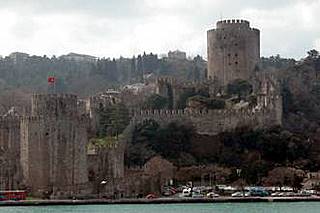 As you leave the main part of Istanbul and travel up the Bosphorus towards the Black Sea, one of the first things you see is the Rumeli Hisari fortress built under the orders of the Conqueror Mehmet in 1452 to control commercial and military traffic in preparation for the siege of siege of Constantinople. Some guides say that the fortress was used as a rather impressive Bosphorus toll booth, then as a barracks, later as a prison, and finally as an open-air theatre, but never again as a fortress.
As you leave the main part of Istanbul and travel up the Bosphorus towards the Black Sea, one of the first things you see is the Rumeli Hisari fortress built under the orders of the Conqueror Mehmet in 1452 to control commercial and military traffic in preparation for the siege of siege of Constantinople. Some guides say that the fortress was used as a rather impressive Bosphorus toll booth, then as a barracks, later as a prison, and finally as an open-air theatre, but never again as a fortress. 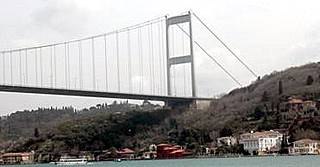 Continuing to travel up the Bosphorus, you pass under the Fatih Sultan Mehmet Bridge. This bridge is named after the Turkish conquer of Constantinople (Fatih means “conqueror”) in 1453. It spans the Bosphorus at its narrowest point—where it is only 0.5 mi. [0.66 km.] wide.
Continuing to travel up the Bosphorus, you pass under the Fatih Sultan Mehmet Bridge. This bridge is named after the Turkish conquer of Constantinople (Fatih means “conqueror”) in 1453. It spans the Bosphorus at its narrowest point—where it is only 0.5 mi. [0.66 km.] wide.
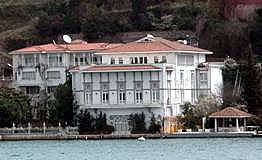


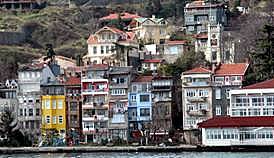
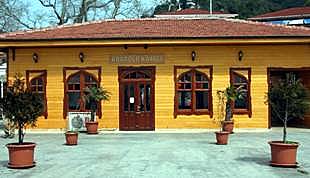



 Q: Tell me about your boat.
Q: Tell me about your boat. 
 The village gained better roads to Lisbon and Sintra, a casino, a bullfight ring, a sport club and improvements in the basic infrastructure for the population. The railway arrived in 1889. Many aristocratic families built beautiful mansions in Cascais, many of which can still be seen in the centre and surroundings of the town. In the 1930s, Cascais’ popularity revived and attracted artists and writers to its little cottages. During WW2 several Kings and heads of European countries and their aristocratic entourages sought refuge in Cascais and nearby Estoril. Today Cascais is a dormitory town of Lisbon but there is still a lot to see and do.
The village gained better roads to Lisbon and Sintra, a casino, a bullfight ring, a sport club and improvements in the basic infrastructure for the population. The railway arrived in 1889. Many aristocratic families built beautiful mansions in Cascais, many of which can still be seen in the centre and surroundings of the town. In the 1930s, Cascais’ popularity revived and attracted artists and writers to its little cottages. During WW2 several Kings and heads of European countries and their aristocratic entourages sought refuge in Cascais and nearby Estoril. Today Cascais is a dormitory town of Lisbon but there is still a lot to see and do.  Cascais is still a small, pretty fishing port which is small enough to be explored on foot over the course of a weekend. The town is dominated by a small beach with a still active fishing industry. There is a pretty harbour with lots of splendid yachts mixed with small fishing boats. Legend even has it that it was a Cascais fisherman, a certain Afonso Sanches, and not Columbus who discovered the New World ten years before the famed date of 1492.
Cascais is still a small, pretty fishing port which is small enough to be explored on foot over the course of a weekend. The town is dominated by a small beach with a still active fishing industry. There is a pretty harbour with lots of splendid yachts mixed with small fishing boats. Legend even has it that it was a Cascais fisherman, a certain Afonso Sanches, and not Columbus who discovered the New World ten years before the famed date of 1492. 
 There is the Museu do Mar that depicts the story of Cascais and its fishing history. Three kilometres, about a 20-minute walk along the coastal road outside town is the Boca do Inferno where on rougher days the sea hammers into the rock through a blow hole creating spectacular spray giving meaning to the English translation of “mouth of hell.” A small piece of trivia: Aleister Crowley came to Boca do Inferno to fake his own death in 1930. It is possible to walk all the way from Cascais to Estoril along a waterfront boardwalk where you can see plenty of beaches, though these can become crowded in the summer months.
There is the Museu do Mar that depicts the story of Cascais and its fishing history. Three kilometres, about a 20-minute walk along the coastal road outside town is the Boca do Inferno where on rougher days the sea hammers into the rock through a blow hole creating spectacular spray giving meaning to the English translation of “mouth of hell.” A small piece of trivia: Aleister Crowley came to Boca do Inferno to fake his own death in 1930. It is possible to walk all the way from Cascais to Estoril along a waterfront boardwalk where you can see plenty of beaches, though these can become crowded in the summer months.
![logo[1]](https://globetrotters.co.uk/newsletter/wp-content/uploads/sites/2/2006/10/logo1.jpg)
![Corb-and-House-flat[1]](https://globetrotters.co.uk/newsletter/wp-content/uploads/sites/2/2006/10/Corb-and-House-flat1-233x300.gif)
